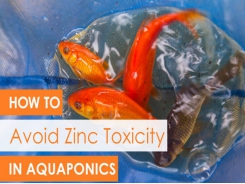Ich (White Spot Disease) - Part 1

Ich is a common name for the par- asite Ichthyophthirius multifiliis and the disease that it causes. The parasite is capable of killing large numbers of fish in a short period of time. Early diagnosis and treatment are essential for controlling Ich and reducing fish losses. Prevention of this disease is, of course, the best method of avoiding fish mortalities.
Identification of Ich
Fish infected with Ich may have white specks on their skin as though they were sprinkled with salt (Fig. 1). Because of this appearance, Ich is sometimes called white spot disease. The skin of the fish may also look bumpy. Mature forms of the parasite are large (up to 1 mm or 1/32 inch across) and can be seen without magnification. Ich often causes the fish to have large amounts of mucus sloughing off of their skin, an appearance which may resemble fungus when viewed from a distance in the water. Many times, however, the only indication of Ich’s presence may be dead and dying fish. In some Ich cases the parasite may be present only on the gills and not on the skin.
Fish with Ich may be observed making quick rubbing or scratching movements on objects or on the pond bottom. This behavior is sometimes called “flashing” because of the quick and sudden exposure of the fish’s light-colored belly as it rolls during erratic movements. Trout have been observed flashing at the water surface, appearing as though they are striking at insects. In the final disease stages, Ich-infected fish also may appear lethargic and sometimes gather around inflowing water. Infected fish usually refuse to eat.
Under the microscope, Ich appears as a sphere that changes shape and moves around in a rolling motion, using tiny hairs called cilia that totally cover the parasite. Its method of motility is often compared to that of an amoeba. The center of the adult organism has a C-shaped nucleus (Fig. 2). The small infective stages do not have the C-shaped nucleus, and they move in the water rigidly, as opposed to the fluid, rolling movement of the adult. In advanced stages of infection, Ich is found burrowed under the mucus and top layer of cells (epithelium) in the fish’s gills or skin. After burrowing, Ich is very hard to treat because of the protective layer of mucus and host cells covering the parasite. Prompt treatment is important to help prevent the establishment of an advanced infection.

Figure 1. White specks on the skin of a catfish infected with Ichthyophthirius multifiliis. (Photo by Dr. Bob Durborow.)

Figure 2. C-shaped nucleus of an adult Ich organism. (Photo by Dr. Fred Meyer.)
Life cycle of ICH
Ichthyophthirius multifiliis is a pro- tozoan parasite that usually is transmitted into a pond by a car- rier fish, other animals, or man. It can be pumped into a pond from a river or stream used as a water source for the pond. When the Ich adult leaves the infected fish, it is called a tomont (Fig. 3). The tomont attaches to the pond bot- tom or other surface and forms a thin-walled cyst. Within the cyst, the tomont divides many times, forming as many as 2,000 small tomites. When the tomites are released from the cyst into the water, they elongate and become theronts. These theronts (also called swarmers) swim to a fish host and penetrate the fishÕs epithelium using a penetrating gland and the strong swimming action of their cilia. If they do not find a fish host within a day or two they usually die. This makes Ich an obligate parasite; it must have a fish host to survive. Once they penetrate the fish they are referred to as trophonts. Trophonts feed on the host fish and mature while being protected from chemical treatment under the fish’s mucus or epithelium. Only the theront and tomont stages are sensitive to treatments in the water.

Figure 3. Life cycle of Ichthyophthirius multifiliis. (Drawing by Wyvette Williams and Drew Mitchell.)
The amount of time needed for Ich to complete its life cycle is temperature dependent. Ich com- monly infects fish between 68ºF and 77ºF (20ºC to 25ºC), but infec- tions do occur at colder temperatures (as low as 33ºF, 1ºC). Typically, Ich cannot reproduce properly at water temperatures above 85ºF (30ºC), so the parasite usually does not cause prob- lems in warm summer months. However, in a case in central Florida, Ich was responsible for killing fish at 92ºF (33ºC). To complete its life cycle, Ich requires from less than 4 days (at tempera- tures higher than 75ºF or 24ºC) to more than 5 weeks (at tempera- tures lower than 45ºF or 7ºC).
Researchers have discovered that the Ich parasite can multiply directly by dividing underneath the fish’s top skin layer, bypassing the usual three-stage life cycle. When this occurs, one can see multiple Ich cells of similar size lined up or in clumps underneath the thin layer of host cells (Fig. 4). Ich is not treatable when it becomes established to this degree and reproduces in this manner, because it does not need to leave the host where it would ordinarily be vulnerable to treatment.

Figure 4. Ich infection under the epithelial layer of the gills. (Photo by Drew Mitchell.)
Có thể bạn quan tâm
Phần mềm

Phối trộn thức ăn chăn nuôi

Pha dung dịch thủy canh

Định mức cho tôm ăn

Phối trộn phân bón NPK

Xác định tỷ lệ tôm sống

Chuyển đổi đơn vị phân bón

Xác định công suất sục khí

Chuyển đổi đơn vị tôm

Tính diện tích nhà kính

Tính thể tích ao hồ



 Ich (White Spot Disease) - Part 2
Ich (White Spot Disease) - Part 2  The importance of digestibility enhancers in current aquafeed…
The importance of digestibility enhancers in current aquafeed…